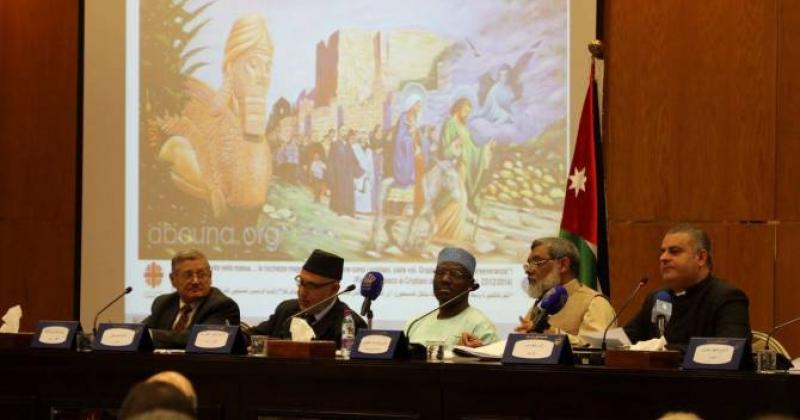The young Iraqi man, who preferred to remain anonymous, confined himself in a classroom in the township of Na'our for long hours on daily bases and for several weeks to depict on a special piece of canvas the exodus trip or rather the forced displacement that was triggered by the mentality of labeling others as infidels and was revealed by its heinous practices in Iraq.
Weeks later, the painting became public as it conveyed a message that art perpetuates an event despite its harshness. Despite the fact that the painting was speechless, yet it covered long distances and flew high at an altitude of 35,000 feet to later land in the hands of Pope Francis--the Pope of simplicity, humility, and the Pope of the special message he addressed to the Christians of the Middle East on the eve of Christmas 2014 saying, "You are the most precious treasure, thank you for your perseverance."
A Jordanian priest took the painting, which represents the trip of forced displacement, on a rainy morning to Rome in order to show it to Pope Francis, who had prayed on the previous Sunday for "the abducted and those pained because of their faith, saying that we do not forget them''.
The painting shows a motley group of displaced people leaving everything behind, with everything "left behind'' subject for sale except their faith that settles in the heart. The displaced are led by three people, with the halos of sanctity about their head, who are well-known as the "the Holy Family'', namely Virgin Mary, St. Joseph and baby Jesus Christ in the arms of his mother who seems to be exhausted. Why did the Iraqi artist add this family to the painting of the displaced Iraqis? He did this because it is the first displaced family fleeing the oppression of Herod as it was forced to leave Bethlehem for Egypt because of oppression and the killing of the children of Bethlehem who were under two years of age. This family left for Egypt, the same country which a friend of the Iraqi painter drew another painting depicting Lord Jesus falling under the cross with 21 Coptic Egyptians dressed in orange whom we called the "martyrs of the 21st century. Nowadays Herod has new names among which is an organization that forced these families to follow the example of this "family" despite the change in the way and direction. It represents the Way to the Cross which the Holy Family experienced before the "exhausted child" did. He is the One to say in the streets of Jerusalem prior to the Way to the Cross: “Come to me, all you who are weary and burdened, and I will give you rest. Take my yoke upon you and learn from me, for I am gentle and humble in heart, and you will find rest for your souls. For my yoke is easy and my burden is light.”
The right side of the painting shows the walls of Nineveh, part of which is demolished. All the figures in the painting keep moving including the priest, the nun and the elderly who were wearing the traditional clothing of Nineveh, Mosul, Qaraqoush Tal Afar and others. There are also children, young men and women, and a child held close to the chest of his father, who seems to be sick and exhausted. The caravan proceeds while the guardian angel looks at the Holy Family with one eye and at the displaced families with the other eye. The angel laments what Herod did, but recalls that the world nowadays does not care about Herod and his two sons--where one them killed John the Baptist in the township of Mkawer which is frequented by pilgrims and tourists from around the world. These tourists do not say 'how great Herod and his sword is which beheaded John the Baptist, the martyr of truth and dignity.' They rather say, "O John the Baptist, as you took your name from the baptism of the baby weeping at the chest of his mother, intercede for an expelled and displaced people who were warmly received by your country , Jordan. This is what Jordan's King Abdullah II said one day prior to handing the painting: " All member of motley community in this homeland rally around Jordan, Muslims and Christians, in order to help the future generations compete and attain openness."
